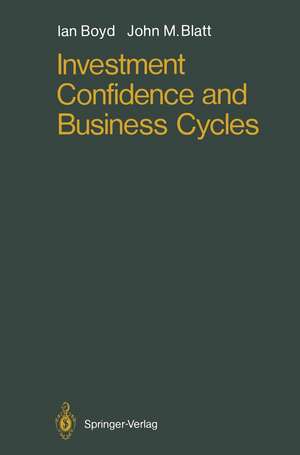Investment Confidence and Business Cycles
Autor Ian Boyd, John M. Blatten Limba Engleză Paperback – 6 dec 2011
Preț: 380.25 lei
Nou
Puncte Express: 570
Preț estimativ în valută:
72.76€ • 76.17$ • 60.20£
72.76€ • 76.17$ • 60.20£
Carte tipărită la comandă
Livrare economică 05-19 aprilie
Preluare comenzi: 021 569.72.76
Specificații
ISBN-13: 9783642731204
ISBN-10: 3642731201
Pagini: 160
Ilustrații: VIII, 149 p.
Dimensiuni: 155 x 235 x 8 mm
Greutate: 0.23 kg
Ediția:Softcover reprint of the original 1st ed. 1988
Editura: Springer Berlin, Heidelberg
Colecția Springer
Locul publicării:Berlin, Heidelberg, Germany
ISBN-10: 3642731201
Pagini: 160
Ilustrații: VIII, 149 p.
Dimensiuni: 155 x 235 x 8 mm
Greutate: 0.23 kg
Ediția:Softcover reprint of the original 1st ed. 1988
Editura: Springer Berlin, Heidelberg
Colecția Springer
Locul publicării:Berlin, Heidelberg, Germany
Public țintă
ResearchCuprins
I. Introduction and Brief Summary.- II. A Brief Historical Survey of the Trade Cycle.- Section A: Why the nineteenth century?.- Section B: Classification of Cycles.- Section C: The Crash of 1873.- Section D: Asymmetry between Rise and Fall.- Section E: The Speed of the Crash.- Section F: Some Stylized Facts.- III: Literature on Confidence.- Section A: John Stuart Mill.- Section B: Walter Bagehot.- Section C: Alfred Marshall.- Section D: Pigou.- Section E: F. Lavington.- Section F: John Maynard Keynes.- Section G: Hyman Minsky.- Section H: Conclusion.- IV: The Dominant Theories.- Section A: Hicks Type Theories.- Section B: Frisch Type Theories.- Section C: Disproof of Frisch type models.- Section D: Goodwin Type Models.- V: A First Look at the New Model.- Section A: The Actors.- Section B: The Plot.- VI: Confidence.- Section A: The Horizon of Uncertainty.- Section B: Increasing and Decreasing Confidence.- Section C: The Money Market.- Section D: Random Effects.- VII: Description of the Model.- Section A: Prices.- Section B: The Desired Investment Fraction.- Section C: Financial Investment and Consumption.- Section D: The Bankruptcy Rate.- Section E: Flow of Funds and Activity of Entrepreneurs.- Section F: Group 3.- Section G: Simulations of the Model.- VIII: The Longer Run.- Section A: General Discussion.- Section B: The Money Supply.- Section C: Effects of an Increase in the Money Supply.- IX: Some General Remarks.- Section A: The Economic Function of the Trade Cycle.- Section B: Exploitation.- Section C: Implications for Economic Theory.- Appendix A: Asymmetry of the Cycle.- Appendix B: Symmetry Theorems for Frisch Type Models.- Appendix C: Specification of the Model.- The Model Equations.- Equations for group 1.- Equations for group 2.- Equation for group 3.- Random Shock Terms.- Conditions and Restrictions.- Numerical Values.- Appendix D: Impossibility of Balanced Growth.- Appendix E: Computer Simulation Method.- Smoothing of the Equations.- Numerical Integration Method.- References.










